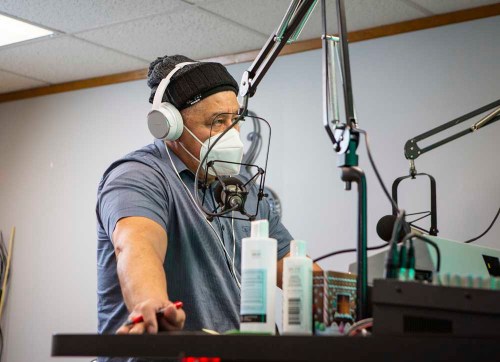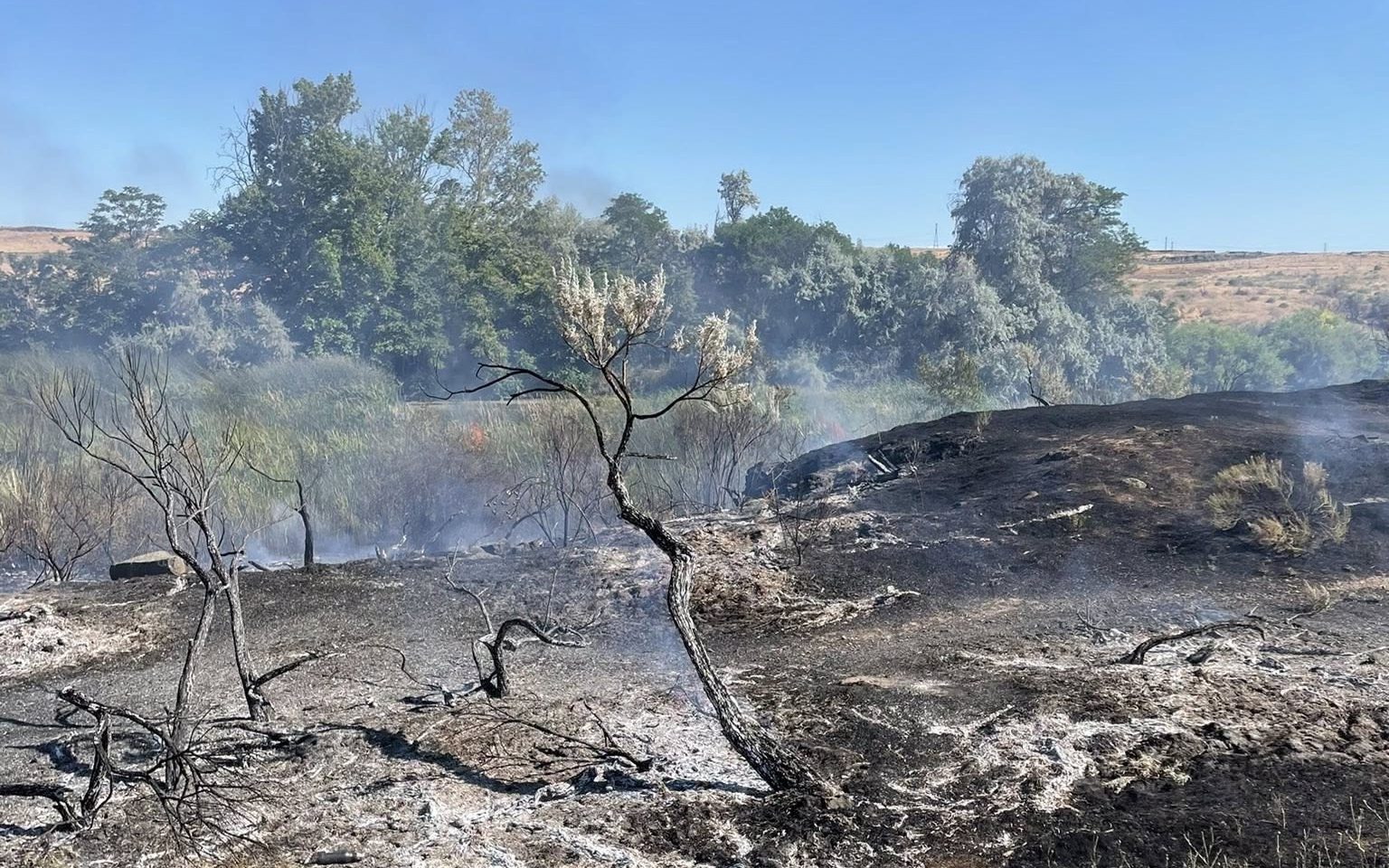‘We failed them:’ New data shows Hispanic residents disproportionately impacted by COVID-19 in 2020
Published 7:00 am Tuesday, March 16, 2021

- Jose Garcia interviews a caller about their experience with COVID-19 during Radio La Ley’s “La Voz Del Pueblo” on Jan. 24, 2021. The Spanish language radio program aimed to help dispel rumors about COVID-19 and share first-hand accounts of those who were dealing with the virus.
PENDLETON — New data released by the Umatilla County Public Health Department shows what was long understood but had yet to be disclosed — Hispanic residents have been disproportionately infected with COVID-19 in the county.
Residents reporting Hispanic ethnicity accounted for 41% of Umatilla County’s total COVID-19 cases in 2020, compared with 34% from non-Hispanic residents and 25% from residents whose ethnicity was unknown, according to a report released by the health department this week.
In addition, the county’s Hispanic population tested positive at a rate approximately three times higher than non-Hispanic residents in 2020, the data shows.
“We failed them,” said Jose Garcia, chair of the Hispanic Advisory Committee in Hermiston. “We failed some communities. Because for every death that happened in Umatilla County, there was a family involved.”
Hispanic or Latino people make up nearly 28% of Umatilla County’s population, according to 2019 U.S. Census data.
“I did anticipate that, just from everything I’d seen so far,” Halley Maloy, the county’s epidemiologist, said of the new data showing the pandemic’s disproportionate impact on the Hispanic community.
The report, which Maloy assembled over the last several months, details a variety of trends and data points related to the pandemic, from hospitalizations to reported deaths and infection rates based on traits like age, gender, race and ethnicity.
The data provides the first look at how the pandemic has impacted a community long understood to be especially vulnerable to COVID-19.
A common trend
Similar disparities have been reported in Morrow County, where Hispanic residents have accounted for nearly 57% of the county’s 1,053 total coronavirus cases, according to data provided by county officials on Friday, March 12. And of the county’s 14 reported deaths, six were reported from Hispanic residents.
Approximately 38% of Morrow County’s population is Hispanic or Latino, according to 2019 U.S. Census data.
Hispanic residents make up a sizable portion of both Umatilla and Morrow counties’ essential workforce, officials from both counties say, often working in food factories and other large agricultural industries where they are at increased risk of infection, and in some cases going home to multi-generational households afterward.
“They were hit hard by this,” Joe Fiumara, Umatilla County’s public health director, said of the pandemic’s impact on the Hispanic community. “Whether we didn’t get messaging to them, whether they (had to) come into work because they needed a paycheck or couldn’t do the work remotely — I think all of those things play into that. And I think this data supports those assumptions.”
Since the early months of the pandemic, national data has shown that Black and Latino people are infected, hospitalized and die from COVID-19 at especially high rates. The disparities spanned across the country in hundreds of urban, suburban and rural areas and counties, and in all age groups, according to the New York Times.
Researchers point to socioeconomic status, unequal access to health care, and workplace exposures in frontline, essential and critical infrastructure jobs as factors contributing to such disparities.
In September 2020, Hispanic and Latino people had a disproportionate rate of infection in 45 states and the District of Columbia, according to an analysis of national coronavirus data from NPR.
Today, Hispanics and Latinos are 1.3 times more likely to contract COVID-19 than White or non-Hispanic people, according to the Centers for Disease Control and Prevention. The population is also more than twice as likely to be hospitalized and more than three times more likely to die from COVID-19 than White or non-Hispanic people, according to the C.D.C.
Hispanic Oregonians have accounted for 34% of all coronavirus cases since the pandemic began, despite making up just 13% of the state’s population, according to data from the Oregon Health Authority as of March 10, 2021.
In Umatilla County, Hispanic residents were hospitalized with COVID-19 at a higher rate than non-Hispanic residents, but reported fewer hospitalizations overall in 2020, the data shows.
For reported COVID-related deaths in 2020, 10 were from Hispanic residents in Umatilla County, seven less than non-Hispanic residents, though 36 reported deaths came from residents whose ethnicity was unknown, the data shows.
Working conditions drive summer surge
The new data shows that residents reporting their ethnicity as Hispanic had the greatest number of Umatilla County’s cases in every month from April through August 2020.
The greatest disparity came in July, when the county reported 1,435 cases, more than any month in 2020. In that month — a month where Umatilla County became the epicenter of high infection rates in Oregon — Hispanic residents accounted for more than half of the county’s cases.
“We knew it was a lot,” Fiumara said. “It is somewhat jarring to see just how, when you look back at July — it is shocking to see how pronounced that came out to be.”
Working conditions were a major part of what drove the summer COVID-19 surge in the county, Fiumara said, adding that many of the cases were traced back to outbreaks in workplaces like food processing plants.
In July, Hispanic residents tested positive at a rate nearly four-and-a-half times higher than non-Hispanic residents, the data shows.
Many of those cases were reported in the 97838 ZIP code that encompasses the city of Hermiston, Fiumara said. The area reported the most COVID-19 cases in 2020, and more than twice as many as Pendleton’s ZIP code, which had the second most, according to the report.
“When we look at where a lot of our industry that was hit hard by this is at, a lot of our food processing, a lot of our agricultural workers, a lot of that falls into that ZIP code,” Fiumara said.
Cases declined in the late summer and early fall, but rose again through November and December 2020. At that time, more cases were coming from social gatherings around the holidays rather than workplace outbreaks, and many of those cases were reported in the Pendleton area, Fiumara said.
“It was really (spreading) in different circles,” he said. “The summer wave seems to have heavily hit the frontline agricultural food processing worker. The November time frame was more about the family gathering piece.”
In October through December, residents reporting non-Hispanic ethnicity had the greatest number of total COVID-19 cases, though in every month of 2020, the county’s Hispanic population tested positive at a higher rate, the data shows.
Disclosing the data
County officials and leadership have for months said that Umatilla County’s Hispanic and Latino population had been hit especially hard by the pandemic, but were reluctant to publish data showing this, fearing the totals would create a stigma, even as counties across Oregon and the U.S. had already begun doing so. Morrow County released data showing the pandemic’s toll on its Hispanic community in a public meeting in January.
“There was already some east county versus west county finger pointing, and if some of these numbers were put out and it was so black and white like this, it was really going to do more to inflate that as opposed to helping solve anything,” Fiumara said of the health department’s initial reluctance to publish the data.
The health department chose to release the data now in an in-depth report to allow residents to see for themselves how the pandemic impacted the county, officials said. The report can be found on the county health department’s website.
Garcia said he remains concerned that the data is now public.
“Think about all the hate crimes we’re seeing against Asian’’ people, Garcia said. In some areas of the country, Asian Americans have experienced higher rates of violence during the pandemic, which some critics say was fueled by racist comments from former President Donald J. Trump, who called the coronavirus “the China virus” or the “Kung Flu.”
“It might get to that point here in Umatilla, where people are pointing the finger at you,” Garcia said.
Regardless, Garcia said he is glad the data has been published. He hopes that, with the information out there, it could encourage people or organizations to reach out and help his community.
“It serves two ways,” Garcia said of the new data. “We might have some people with racial biases, like a stigma, but at the same time, it’ll be good for the experts to say, ‘Let’s focus our resources on Umatilla County and let’s get it done.’”
Officials in both Umatilla County and Morrow County have voiced outrage over the lack of vaccines allocated from the state in recent months, saying the state is failing at its promises to focus vaccination efforts on minority communities that are at high-risk of contracting COVID-19.
Garcia said he hopes that with data published, it will motivate vaccination efforts toward the Hispanic community in the coming weeks and months.
“I’m just hoping that there’s a light at the end of the tunnel,” he said. “With everybody working together. With the researchers, the local authorities, the commissioners being able to say, ‘Now that we know that Hispanics are at a greater risk, we’re going to put our efforts here and vaccinate every one of them who wants it.’”






